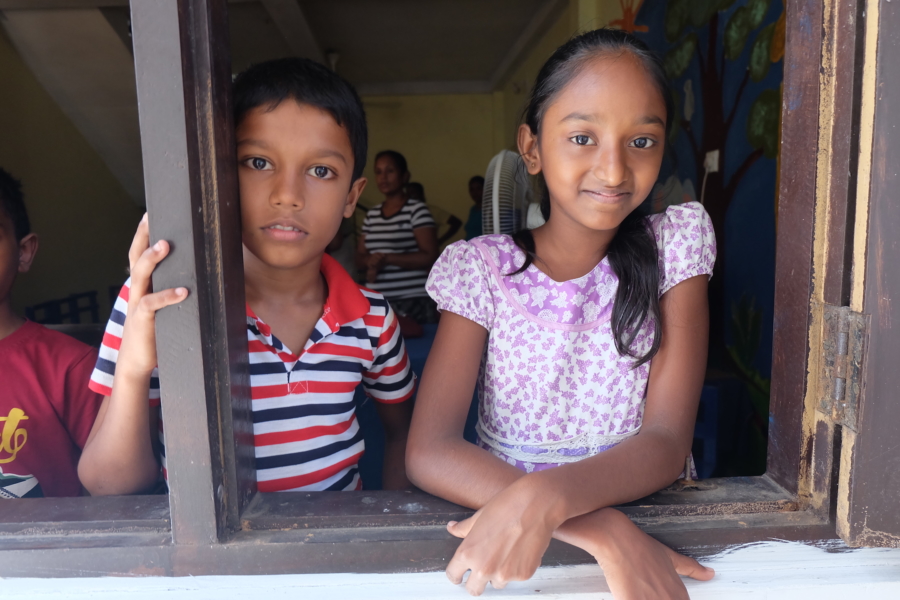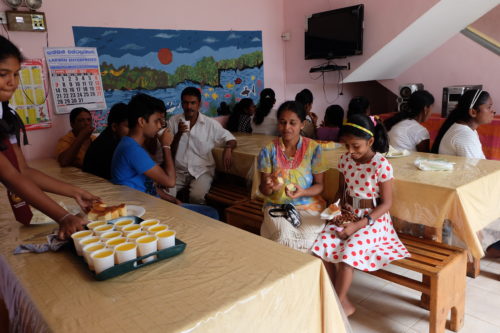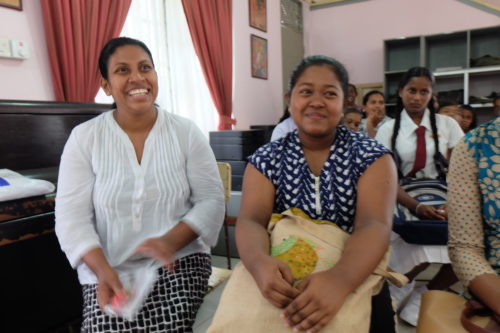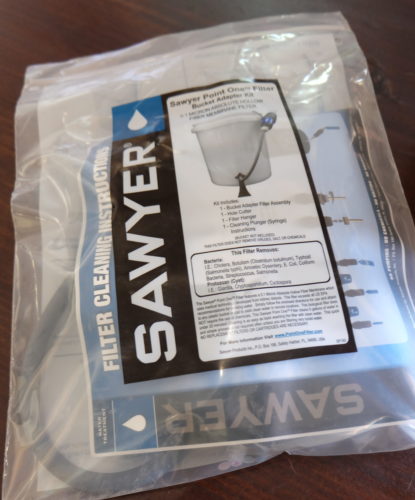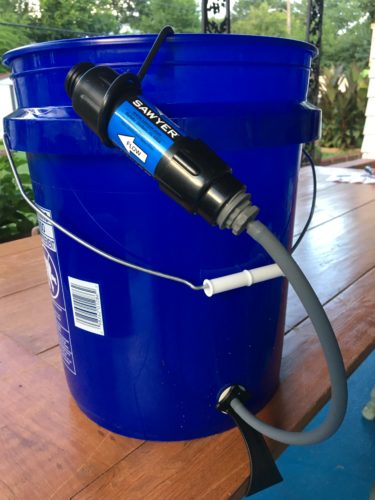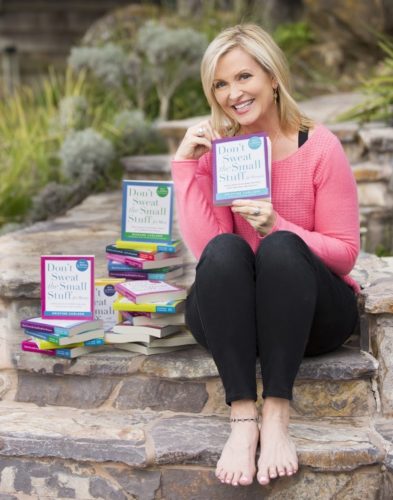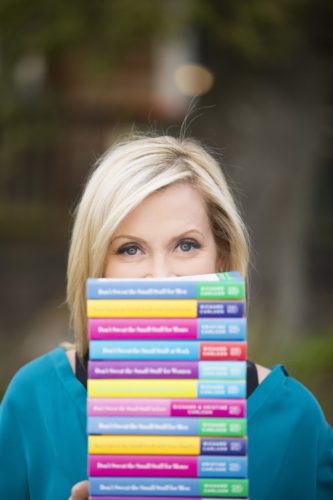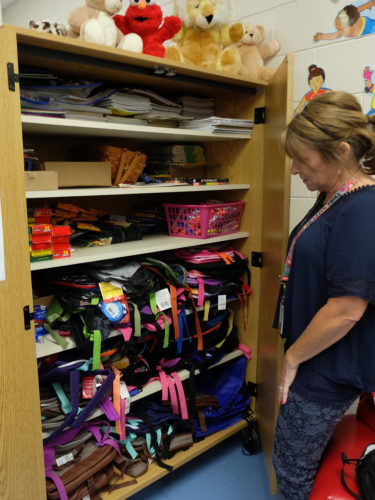The country of Sri Lanka has always valued the importance of learning, and even more so after gaining their independence from Britain in 1948. Since then, the government has made education a high priority, and it has paid off. The literacy rate is over ninety percent — the highest in all of South Asia – and enrollment in school for both boys and girls is just as high. This is in large part due to the well-developed network of public schools in the country, giving children more opportunities to be educated than many other developing or underdeveloped countries where Children Incorporated works.

Dr. Rodrigo speaks with one of our sponsored children outside the center.
At the Chrishanti Lama Sevana Center in Colombo, poor children living in surrounding neighborhoods are given a place to gather after school to study and learn English, math, Sinhalese, dance, art, and sewing, which not only helps to propel them academically, but it also keeps them off the streets.
Although our Volunteer Coordinator at the center, Dr. S.N. Rodrigo, tells us that the neighborhood isn’t unsafe, and that the children are well cared for by their mothers, she feels that it is important that the children have something to do in the afternoons, because there is a drug problem in the area, and she worries that people who don’t have jobs or much to do could negatively influence impressionable children.
Keeping kids off the streets
Knowing that the poor children who lived close to her were at risk was exactly the reason that Dr. Rodrigo started the Chrishanti Lama Sevana Center 35 years ago. She and her husband bought a home in Colombo in the 1970s, when she was still a practicing physician, and her husband was a surgeon.
Dr. Rodrigo connected with Children Incorporated in the early 1980s, when our founder, Mrs. Jeanne Clarke Wood, traveled to Sri Lanka to expand our programs in Asia. Dr. Rodrigo and her husband are both retired now, and they fill their time with taking care of the dozens of children that go to the center every day, ranging from six to eighteen years old. Twenty-two of the children who attend are currently enrolled in our program, and six are awaiting sponsorship.
Even though many of our sponsored children come from similar situations where jobs are scarce or low-paying, it was encouraging to hear from Dr. Rodrigo about how motivated the children are to learn.
Dr. Rodrigo picked me and Luis Bourdet, our Director of International Programs, up to take us to the center, and she talked about how when they first moved into the neighborhood, there were many shanties and mud huts, and she would see children running around outside of her home that were unkempt and dirty, and not in school during the day. She first started helping them by providing them with meals; and she eventually found a small hut to use as a home base to meet with them more regularly.
It wasn’t until five or six years ago, after having partnered with the Chrishanti Lama Sevana Center for nearly three decades, that Luis convinced Dr. Rodrigo to let Children Incorporated build a proper center, thanks to a donation from a special sponsor who wanted to support infrastructure at our international projects.
Dr. Rodrigo was hesitant at first, being unsure as to whether or not she could handle the work that would go into managing a larger building. But after managing to secure a piece of land from the government, she agreed to the construction; and now the center is a two-story building that offers plenty of room for the children to gather, and space for a certified teacher to work with the children every day after school.
Breaking the cycle of poverty
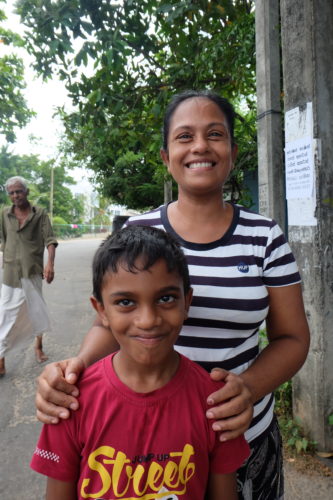
One of our sponsored children and his proud mother
While we were visiting the center, Dr. Rodrigo introduced us to one of the mothers in the neighborhood who is a former sponsored child. Dr. Rodrigo considers this mother’s story the greatest success story for the center.
The mother received support from her sponsor throughout her childhood, and after graduating from high school, she opened a store in her home to sell dry goods, in order to generate money for her family. Her husband drives a tuk-tuk (a three-wheeled motorized vehicle used as a taxi) to earn an income, and they have two children. Their daughter is now in our program, and their son graduated a few years ago, after having a sponsor for many years, and is now working towards becoming an engineer.
Thanks to the mother’s sponsorship support growing up, and to the parents’ dual income now, their children have better educational opportunities than they ever had, which has helped this family break the cycle of poverty. What’s more, the mother is giving back to the Center after so many years of receiving support — Dr. Rodrigo has put her in charge of purchasing items for our sponsored children! She typically buys food, school supplies, soap, toothbrushes, rice, tea, clothing, and shoes, and on a monthly basis, determines which items will best help each individual child in our program.
Motivated to learn
As we continued to meet with our sponsored children throughout the day, we heard stories about how their parents struggle to make ends meet. We met a family who sells fruit at the local schools, but loses their income during the month-long breaks from school that happen three times a year, making it hard to provide for their children. Thanks to sponsorship, the kids receive food when money is especially tight for the parents.
Even though many of our sponsored children come from similar situations where jobs are scarce or low-paying, it was encouraging to hear from Dr. Rodrigo about how motivated the children are to learn. Academics in Sri Lanka are very competitive, and the children work hard to stay on top of their studies. Despite the barriers that poverty creates, many kids aspire to careers beyond just becoming drivers and seamstresses — many of them want to become engineers and doctors, just like Dr. Rodrigo and her husband.
Children dream big in Sri Lanka, and even though they face many challenges, they have opportunities to excel, thanks to places like the Chrishanti Lama Sevana Center, which help prepare them for the future. In Sri Lanka, the possibilities for success are real, and our sponsored children are reaching for their goals.
***
HOW DO I SPONSOR A CHILD IN SRI LANKA?
You can sponsor a child in Sri Lanka in one of three ways: call our office at 1-800-538-5381 and speak with one of our staff members; email us at sponsorship@children-inc.org; or go online to our donation portal, create an account, and search for a child in Sri Lanka that is available for sponsorship.

